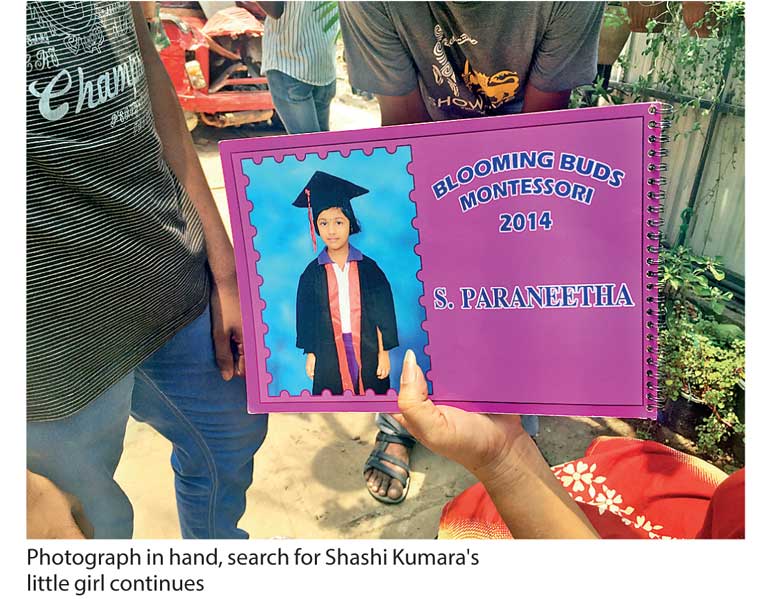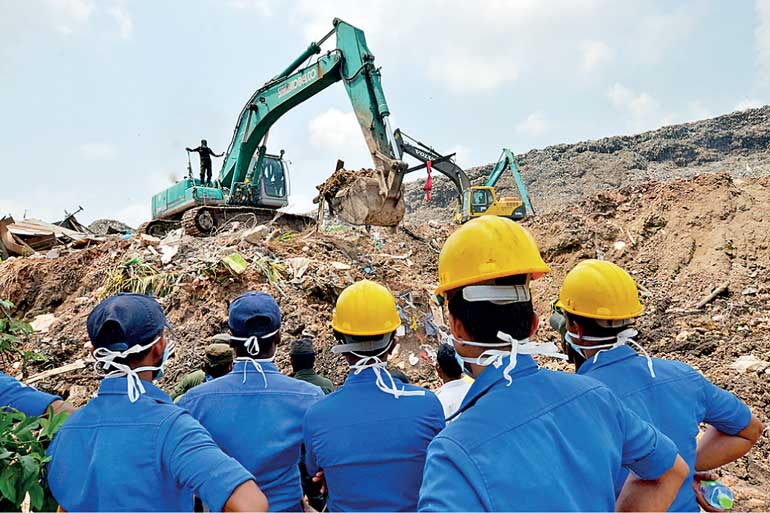Monday Apr 07, 2025
Monday Apr 07, 2025
Wednesday, 19 April 2017 00:00 - - {{hitsCtrl.values.hits}}
 By Chathuri Dissanayake
By Chathuri Dissanayake
Unwilling to leave their homes and the possessions they have collected over a lifetime, R. Ellen (76), her neighbour and daughter sit by the roadside staring at the Meethotamulla dumpsite. Across the small footpath from where she is seated, her partially damaged house bears the weight of two more houses which were uprooted during the disaster on 14 April.
“We were getting ready to visit a relative for Avurudu. We just finished washing up and were hurrying out. Had we been delayed we would have gotten crushed in the rubble because a house which was uprooted landed on our bathroom,” Ellen said, adding that she and her daughter were both lucky to be alive.
Shashi Kumar, another resident of Meethotamulla, was not as lucky. With a picture of his eight-year-old daughter in his hand, he stares at the excavation work being carried out, waiting for the rescue workers to find his daughter. Despite the instructions given by the Sri Lanka Police and Sri Lanka Army to evacuate the area, he and his mother-in-law insist on remaining in the immediate disaster zone to “help and point out areas” for the rescue workers to look for his daughter. He had already buried his wife, her aunt, his grandmother and his 12-year-old son. His youngest son survived.
“It is a miracle he survived. We just got out of the three wheeler after returning from the Kovil. The three wheel driver suddenly screamed saying there was a load of soil coming our way and we all ran. My wife and children had run in the same direction as the oncoming garbage mountain,” he recalled.
Kumar has followed the same routine for the last three days. As day breaks he comes to the plot where he saw his child last with the hope of finding his daughter’s body, at least to give her a decent burial, but as the day came to an end, so did his expectations.
Hope for survivors dwindled as the fourth day came to an end. Yesterday three more bodies were uncovered but officials were reluctant to announce the final death toll before verification. To date, 32 deaths have been confirmed. A victim receiving treatment in hospital succumbed to his injuries this evening. The number of missing varied as residents were slow in filing reports.
Troops are now mainly engaged in clearing the area, Army Spokesperson Brigadier Roshan Seneviratne said. The 1,000 troops deployed in the disaster zone are now working to clear the area. “We have still not been able to clear at least the access paths in the area. We are still engaged in clearing that,” he told the Daily FT.
The authorities are also unable to assess the impact as the community has not come forward to file missing reports, Seneviratne said.
“This area was not always a dump. We didn’t come to squat in a garbage site, the garbage came to us. We had a paddy field here when we first came to live here about 42 years ago,” recalled Ellen.
“Later the area was developed by President Ranasinghe Premadasa. He even gave us a loan to construct our houses. We obtained Rs. 15,000 as a loan in 1990. Since then our children have built the rest.”
Her property lay in a low-income housing scheme called ‘Dahampura’, which was declared open in 1987 by then President Premadasa. Her family, like most others in the scheme, has built their house on a plot of five perches. In many of the houses, two or three people lived crammed together in the small area.
Although Ellen obtained a loan to build the house, she still doesn’t have a deed for the house her family has been living in for 42 years. When she tried obtaining the deed a few months back, it was held back after the family was told it had not repaid the loan obtained from the Housing Authority, although she claims the same was written off many years ago. These letters and official documents also lie abandoned in the house.
Ellen refuses to give up hope of recovering her family assets in the house. For her it’s a lifetime of earnings.
“We had two sewing machines, an almirah and two beds. That’s all we have after we lost most of it during last year’s floods,” she said.
Following the disaster in Meethotamulla, the Colombo Municipal Council, which dumped 800 tonnes of waste at the site every day, attempted to dispose of the waste at the Kotikawatta site, another dumping ground in Kolonnawa, where it was met with opposition from the area’s residents today.
A tense situation arose as Police attempted to disperse the crowd. Following negotiations the community called off the protests after local government members agreed to stop dumping waste at the site and provide a police guard at the dumping site to prevent any more attempts.
With no dumping ground available to dispose of the garbage collected, municipal authorities were slow in collecting solid waste in Colombo, allowing it to pile up today. However, Colombo Municipal Commissioner V. K. Anura assured that the crisis would be solved by noon tomorrow.
Pix by Shehan Gunasekara